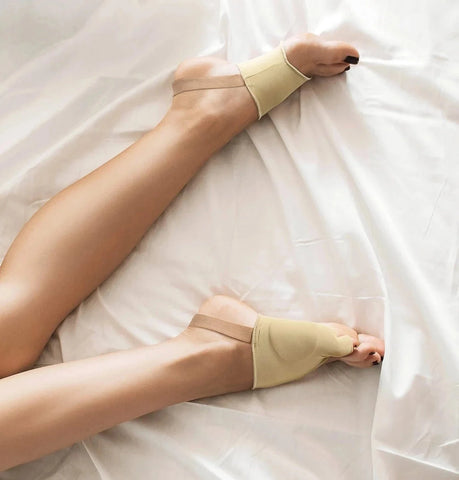Using a Cold Compress for Bunions
Are you a woman in the age group of 45-59, residing in the United States, Canada, Australia and struggling with bunions on both feet? This guide is here to help you understand the benefits and methods of using a cold compress for bunion relief.
The Benefits of a Cold Compress for Bunions
Applying a cold compress to your bunions can help reduce pain and inflammation. Here's why it works...
- Pain Relief - A cold compress can help to numb the area, reducing pain and discomfort associated with bunions.
- Reduces Inflammation - Cold therapy can also help to reduce inflammation, which can contribute to the formation of bunions.
- Easy to Use - Cold compresses are simple to use. You can apply ice wrapped in a towel or soak the affected foot in cold water for short periods of time.
- Safe - When used correctly, cold compresses are generally safe. It's important to wrap the ice pack or cold towel in a thin cloth and apply it to the bunion area for no more than 20 minutes at a time to avoid frostbite or injury to the skin.
- Cost-Effective - Cold compresses are a cost-effective method of treatment that can be done at home.
- Complementary Treatment - A cold compress can be used as part of a conservative treatment plan for bunions, along with other treatments such as orthotics, Orthopedic Sleeves, wearing shoes with a wide toe box, or taping the bunion.
4.9 ⭐⭐⭐⭐⭐ (1840 reviews)
Prevention score: 9/10
Pain relief score: 10/10
Long-term solution: 10/10
How to Use a Cold Compress for Bunions
Using a cold compress for bunions is simple and can be done at home. Here's a step-by-step guide...
-
Prepare the Cold Compress: You can use a store-bought cold pack or make one at home by wrapping ice cubes in a thin towel.
-
Protect Your Skin: Before applying the cold compress, protect your skin by placing a thin cloth or towel between the compress and your skin.
-
Apply the Compress: Place the cold compress on the bunion area.
-
Time It Right: Keep the cold compress on for about 15-20 minutes.
-
Repeat: You can repeat this process every 1-2 hours as needed for pain relief.
Precautions When Using a Cold Compress
While a cold compress is generally safe, there are a few precautions you should take to avoid further complications...
-
Protect Your Skin: Always wrap the ice or cold pack in a thin cloth before applying it to your skin to prevent frostbite.
-
Time It Right: Do not apply the cold compress for more than 20 minutes at a time. Prolonged exposure to cold can damage your skin and tissues.
-
Listen to Your Body: If the cold compress feels too uncomfortable or causes pain, remove it immediately.
-
Avoid Direct Contact: Never apply a frozen item directly to the bunion. Always use a barrier like a cloth or towel.
-
Check Your Skin: After using the cold compress, check your skin for any signs of damage such as blisters or changes in color.
Other Helpful Tips for Bunion Relief
In addition to using a cold compress, there are other ways you can help relieve bunion pain...
1. Wear the right shoes. Wear proper footwear. Your shoes shouldn’t be tight, the toe area should be wide, and the heel should be less than 1 to 2 inches. It should also have good support for the arch of your foot.
2. Avoid flip-flops. Avoid wearing flip-flops and other shoes that have no arch support because they put extra pressure on the big toe joint.
3. Know your measurements. Ask the sales person to measure the length and width of your foot when you are buying shoes to help ensure a good fit.
4. Size shoes by comfort not number. Shoes from different companies may be sized differently. Always go by what is comfortable, not by your usual foot size.
5. Use inserts in your shoes, so your foot is in proper alignment and the arch is supported. You can use the kind sold in drugstores or have prescription orthotics made.
6. Stretch your toes. Remove your shoes for a little while and wiggle your toes when you can at work or at home to reduce the pressure on your toes.
7. Space your toes out. Use toe spacers at night or while wearing shoes to reduce the pressure on your toes.
8. Cushion your bunions. Cover your bunions with bunion pads or moleskin to relieve some of the pressure and make the bunion less likely to be irritated by your shoes.
9. Soak your feet in warm water with Epsom salt to soothe them and reduce inflammation.
10. Ice your foot. Use ice packs to reduce the swelling and inflammation when your bunion gets sore.
11. Take NSAID pain relievers. Take nonsteroidal anti-inflammatory drugs, such as ibuprofen or naproxen, to reduce the inflammation and pain.
12. Elevate your feet when you are sitting down to reduce the swelling and pain.
13. Rest your feet several times a day, especially if you have been on them all day.
14. Massage your foot and manually move your big toe around to keep the tissue soft and the toe flexible. Rolling a tennis ball under your foot is a good way to massage it.
15. Do foot exercises.




